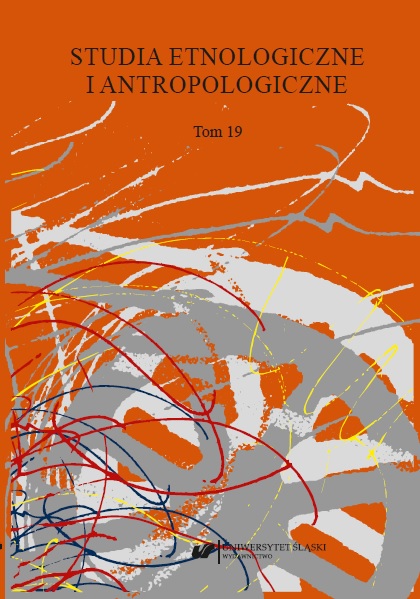Biegeleisen H.: Wesele. Lwów 1928.
Google Scholar
Bisek-Grąz M.: Dziedzictwo kulturowe wałbrzyskiego. Wierzenia, zwyczaje, obrzędy rodzinne. Wrocław 2011.
Google Scholar
Breza E.: Pochodzenie przydomków szlachty Pomorza Gdańskiego. Gdańsk 1978.
Google Scholar
Buchowski M.: Potlacz. W: Słownik etnologiczny. Terminy ogólne. Red. Z. Staszczak. Warszawa-Poznań 1987, s. 288–289.
Google Scholar
Ceynowa F.: Sbjór pjesnj svjatovih które lud słovjanskj v królestvje pruskjim spjevacji lubj. Sesit trzecj: Frantówki, Sętopórkj, Prosjbi na vesele itd. V Svjecju nad Visłą 1878
Google Scholar
Cousin Marriages. Between Tradition, Genetic Risk and Cultural Change. Eds. A. Shaw, A. Raz. New York 2015.
Google Scholar
Damps-Zdrojewska M.: Sierakowice i Somonino z rekordowymi wskaźnikami przyrostu naturalnego. http://kartuzy.info/wiadomosc,33482,Sierakowice-i-Somonino-z-rekordowymi-wskaznikami-przyrostu-naturalnego.html [data dostępu: 26.08.2018].
Google Scholar
Dołowy N.: Kaszubi z Pomorza. Gdynia 2010.
Google Scholar
Drożdż A., Pieńczak A.: Zwyczaje i obrzędy weselne. Cz. 1: Od zalotów do ślubu cywilnego.
Google Scholar
Wrocław–Cieszyn 2004 (Komentarze do Polskiego Atlasu Etnograficznego. T. 8). Fox R.: Kinship and Marriage. Harmondsworth 1967.
Google Scholar
Gulgowski I.: O nieznanym ludzie w Niemczech / Von einem unbekannten Volke in Deutschland. Przeł. M. Darska-Łogin. Red. J. Borzyszkowski. Berlin 1911 – Gdańsk 2012.
Google Scholar
Janiak A.: Zwyczaje i obrzędy rodzinne, sąsiedzkie i zawodowe. W: Niematerialne dziedzictwo kulturowe Pomorza Wschodniego. Cz. 3. Red. A. Kwaśniewska. Gdańsk 2017, s. 147–204.
Google Scholar
Jażdżewski B.: Wspomnienia kaszubskiego gbura. Gdańsk 1999.
Google Scholar
Katarzyńska A.: Klątwa Kaszubów. „Gazeta Wyborcza”, dod. „Nauka”, 19.03.2008.
Google Scholar
Koczyk M.: Aspiracje i perspektywy życiowe młodzieży kaszubskiej. W: Rodzina pomorska. Red. J. Borzyszkowski. Gdańsk 1999, s. 311–325
Google Scholar
Kodeks prawa kanonicznego. https://www.katolicki.net/ftp/kodeks_prawa_kanonicznego.pdf [data dostępu: 26.08.2018].
Google Scholar
Kwaśniewicz K.: Zwyczaje i obrzędy rodzinne. W: Etnografia Polski – przemiany kultury ludowej. T. 2. Red. M. Biernacka, M. Frankowska,W. Paprocka. Wrocław 1981, s. 89–126.
Google Scholar
Kwaśniewska A.: Choroba genetyczna jako klątwa. Analiza i kontekst dyskursu medialnego dotyczącego tzw. genu kaszubskiego. „Lud” 2017, t. 101, s. 231–251.
Google Scholar
Lévi-Strauss C.: Antropologia strukturalna. Przeł. K. Pomian. Warszawa 1970.
Google Scholar
Mordawski A.: Statystyka ludności kaszubskiej. Kaszubi u progu XXI wieku. Gdańsk 2005.
Google Scholar
Obracht-Prondzyński C.: Dylematy edukacyjne z Kaszubami i Pomorzem na pierwszym planie. Gdańsk 2017.
Google Scholar
Obyczaje, języki, ludy świata. Encyklopedia PWN. Warszawa 2007.
Google Scholar
Pacjent z deficytem LCHAD. http://www.wspolczesnadietetyka.pl/rzadkie-schorzenia-metaboliczne/pacjent-z-deficytem-lchad [data dostępu: 5.12. 2018]. Perszon J.: Kaszubi. Tożsamość. Rodzina. Gdańsk 2015.
Google Scholar
Piekutowska-Abramczuk D. et al.: A Comprehensive HADHA c.1528G>C Frequency Study
Google Scholar
Reveals High Prevalence of Longchain 3-Hydroxyacyl-CoA Dehydrogenase Deficiency in Poland. „Journal of Inherited Metabolic of Disease” 2010, suppl. 3, s. 373–377.
Google Scholar
Pieńczak A.: Zwyczaje i obrzędy weselne. Cz. 2: Od zalotów do ślubu cywilnego. Wrocław–Cieszyn 2004 (Komentarze do Polskiego Atlasu Etnograficznego. T. 8).
Google Scholar
Pietraszek E.: Wieś Z. w woj. wrocławskim. W: Wieś dolnośląska. Red. E. Pietraszek. Wrocław 1989 (Prace i Materiały Etnograficzne. T. 29), s. 237–299.
Google Scholar
Przyrost naturalny w Polsce w 2017 r. Pięć regionów na demograficznym plusie. https://www.portalsamorzadowy.pl/polityka-i-spoleczenstwo/przyrost-naturalny-w-polsce-w-2017-r-piec-regionow-na-demograficznym-plusie,109393.html [data dostępu: 26.08.2018].
Google Scholar
„Pulteram” – żywa tradycja w Wielkopolsce. Red. A. Jełowicki. Szreniawa 2017.
Google Scholar
Rauszer M.: Chłop – niewolnik. Pańszczyzna w perspektywie antropologii historii. „Lud” 2017, t. 101, s. 107–127.
Google Scholar
Rodzina pomorska. Red. J. Borzyszkowski. Gdańsk 1999.
Google Scholar
Shaw A.: British Pakistani Cousin Marriages and the Negotiation of Reproductive Risk. W: Cousin
Google Scholar
Marriages. Between Tradition, Genetic Risk and Cultural Change. Eds. A. Shaw, A. Raz. New York 2015, s. 113–129.
Google Scholar
Simonides D.: Od kolebki do grobu. Śląskie wierzenia, zwyczaje i obrzędy rodzinne w XIX wieku. Opole 1988.
Google Scholar
Sortms O.L., Bartels E.: Changing Patterns of Partner Choice? Cousin Marriages among Turks and Moroccans in the Netherlands. W: Cousin Marriages. Between Tradition, Genetic Risk and
Google Scholar
Cultural Change. Eds. A. Shaw, A. Raz. New York 2015, s. 154–175.
Google Scholar
Sykut-Cegielska J. et al.: Urgent Metabolic Service Improves Survival in Long-Chain 3-HydroxyacylCoAdehydrogenase (LCHAD) Deficiency Detected by Symptomatic Identification and Pilot Newborn Screening. „Journal of Inherited Metabolic of Disease” 2011, nr 34, s. 185–195.
Google Scholar
Tyni T., Pihko H.: Long-Chain 3-Hydroxyacyl-CoA Dehydrogenase Deficiency. „Acta Paediatrica” 1999, nr 88, s. 237–245.
Google Scholar
Ustawa z dnia 25 lutego 1964 r. Kodeks rodzinny i opiekuńczy. Dz.U. 1964 nr 9, poz. 59.
Google Scholar
Widernik M.: Lata Drugiej Rzeczypospolitej. W: Dzieje Kartuz. Kartuzy 2001, s. 13–102.
Google Scholar
Zmuda-Trzebiatowski Z.: Łąkie Szlacheckie. Trzebiatowscy 1515–2015. Cz. 4: III Zjazd Rodzin Trzebiatowskich, 17–19 wrzesień 2004. Słupsk–Ustka 2004.
Google Scholar
Archiwum Diecezjalne w Gdańsku. Księgi metrykalne: śluby, Strzelno, 1885–1944.
Google Scholar
Archiwum Diecezjalne w Pelplinie. Księgi metrykalne: śluby, Sianowo, 1808–1912.
Google Scholar
Archiwum parafii w Sianowie. Księgi metrykalne: śluby, 1923–1955
Google Scholar


 https://doi.org/10.31261/SEIA.2019.19.10
https://doi.org/10.31261/SEIA.2019.19.10

 10.31261/SEIA
10.31261/SEIA